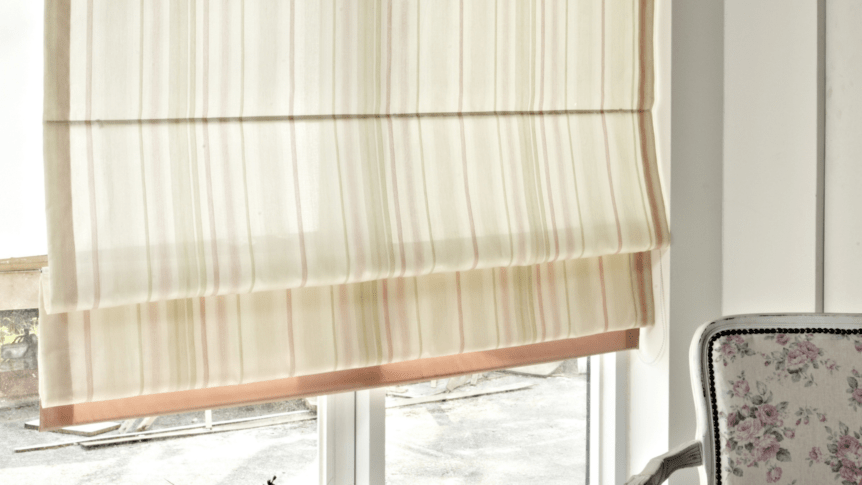Full article with thanks to: houzz.co.uk/magazine/decorating-how-can-i-use-roman-blinds-to-best-effect-stsetivw-vs~34285040
Wondering how to dress your windows? Consider Roman blinds. They can often be the most efficient use of space, especially on smaller windows, and are a good choice if you don’t like the look of curtains. As they use less fabric, Roman blinds can also be an appealing option if you are on a tighter budget, or want to use a decadent choice of fabric as effectively as possible.
Don’t spare any expense on the workings of a Roman blind, though, and remember to budget for a good mechanism. With strict safety measures now in force, it’s also best to choose a fitter who is fully up to speed with the regulations for fitting blinds in the home. If you have small children, or know any who might visit, do not remove the unsightly but life-saving devices added to your blind mechanism that avoids the chances of a child becoming entangled in the cord.
Read on to be inspired by ways to style Roman blinds, including tips on how to set them perfectly in different spaces.
Think about whether to use blackout lining
While you may like using blackout lining on the back of Roman blinds to block out light, there are sometimes good reasons for not using a heavy lining. In this case, the blind looks lovely with the light filtering through the fabric. It really brings life to the beautiful colours.
You can achieve this look in spaces that don’t need to be completely dark for sleeping. This is such a pretty window, and a Roman blind is a great solution when you want to dress a window but still show off the architecture.
Create impact with contrast
Contrasting borders down the leading edges of a Roman blind are a great way to create impact, especially when the blinds are unfurled. If you like plain fabrics, then this is a good way of avoiding any blandness.
In this room, the windows really make an impact despite the plain colours of the blinds, yet the look is sympathetic to the rest of the space.
Use to add pattern to a bathroom
Roman blinds are a neat way to introduce decorative fabric into a bathroom, which can bring a touch of glamour to an otherwise pared-back space. I love the choice of material in this room – it really pulls your eye to the elegant sash window. It also makes sense of the upholstered armchair, the two linking beautifully through colour and pattern without being matchy-matchy.
This is a good example of how much light bleed you get when you set a Roman blind within a window frame, just to the edge of the panes. The blind looks neat this way, but light does seep around the edges. However, this is not an issue in a bathroom, where total darkness isn’t necessary.
Emphasise the proportions of a room
These chunky horizontal stripes are perfect for the period dimensions of this high-ceilinged room. We all know that horizontal stripes aren’t always flattering to wear, but here they pull the eye around the big room and help show off the decorative window mouldings. The design echoes the subtly striped pattern of the parquet, and the gorgeous matt gold tones work beautifully with the rich timbers.
Using blinds has also given the owners enough room for the curved bench at the dining table – something that would have proved tricky with curtains down to the floor.
Decorate a dormer window
Dormer windows like this are the perfect home for a Roman blind, which can be set into the reveal to really show off the architecture of the opening. So the blind doesn’t get lost in the deep space, choose a thick fabric, which hangs more heavily when folded. If the material you like is thinner, you can simply add blackout lining to thicken it – and give you a darker room, too.
A decorative look like this can also be achieved using a dress blind – a blind that doesn’t drop down to the sill but is purely for design purposes. Many people like to dress a window even though they never lower the blinds, and this certainly saves on the fabric costs and the mechanism price.
Box for a crisp, contemporary look
For a more modern look, consider boxing the area around the blind. Although you lose the architectural details of the window frame, the crisp boxing makes the blind look very neat and bang up to date. It’s also a clever solution to the problem of light seeping around the edges of your blinds.
Maximise light with a box pelmet
The combination of a box pelmet and an upholstered blind is a popular choice of window treatment among interior designers because it allows you to set the blind as high as possible, letting in maximum light when the blind is fully raised.
If you want a more bespoke look, you may want to go for a contrasting pelmet fabric or use trimming along the bottom to give added interest.
Celebrate bold patterns
Patterns and stripes work so well on a Roman blind because you get to see the fabric flat on, so the design doesn’t get lost in the folds as it would on curtains. This really shows how you can make a striking design feature from very little material.
Full article with thanks to: houzz.co.uk/magazine/decorating-how-can-i-use-roman-blinds-to-best-effect-stsetivw-vs~34285040
Did you enjoy that? Why not share this article.
Want made-to-measure blinds or shutters? We offer free consultations for potential customers.

